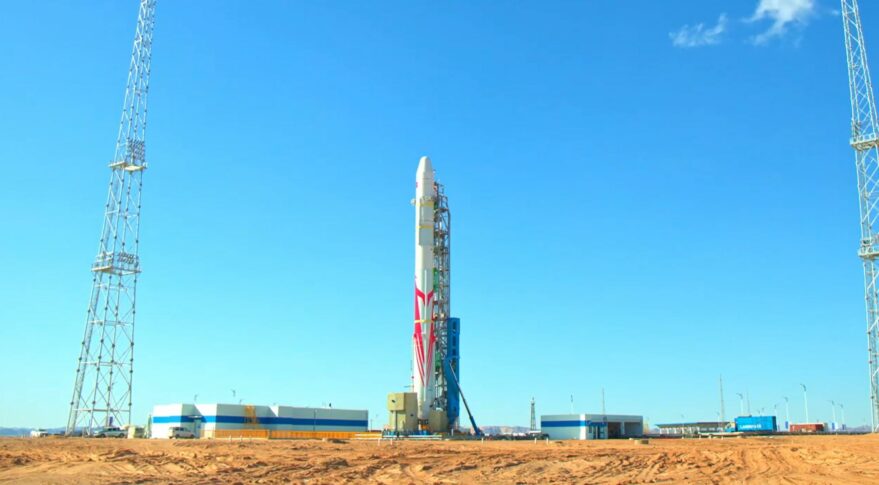HELSINKI — Chinese launch company Landspace suffered failure Wednesday in what was the world’s first attempt to achieve orbit with a methane-fueled rocket.
The Zhuque-2 methane-liquid oxygen rocket lifted off from newly-constructed facilities at the national Jiuquan Satellite Launch Center in the Gobi Desert at around 3:30 a.m. Eastern Dec. 14.
Apparent spectator footage posted on Chinese social media showed the rocket ascending into clear skies, trailed by white exhaust. While the first stage is understood to have performed well, separate apparent leaked footage suggests that issues affecting the rocket’s second stage resulted in the failure of the mission.
Data suggest an expected burn of the stage’s vernier thrusters, intended to carry the stage and payloads into orbit after a burn by the main engine, did not occur as planned.
Chinese launch successes are typically announced immediately after successful orbital insertion. There was still no official announcement of mission success or failure at press time, eight hours after launch.
Looks like Zhuque-2 second stage failed to reach orbital velocity. Satellites lost. Similar to Zhuque-1 launch four years ago. https://t.co/DuDtHVHyyc
— Andrew Jones (@AJ_FI) December 14, 2022
The launch attempt represents a leap by Chinese commercial launch providers despite the failure, marking the country’s first launch attempt of a privately-developed liquid propellant launch vehicle.
Zhuque-2 was carrying a number of satellites for commercial companies and targeted deploying these in a sun-synchronous orbit.
Zhuque-2, which translates to “Vermillion Bird-2,” is powered by gas generator engines and is capable of delivering a 6,000-kilogram payload capacity to a 200-kilometer low Earth orbit (LEO), or 4,000 kilograms to 500-kilometer sun-synchronous orbit (SSO), according to Landspace.
https://t.co/l8j2WPO4Gu pic.twitter.com/RlbRazxL3L
— Ace of Razgriz (@raz_liu) December 14, 2022
The rocket has a diameter of 3.35 meters—the same as a number of national Long March rockets—-a total length of 49.5 meters, a take-off mass of 219 tons and producing 268 tons of thrust.
The mission was also the world’s first orbital launch of a methane-fueled rocket. A range of launch vehicles, including SpaceX’s Starship, the ULA Vulcan, Blue Origin’s New Glenn, Rocket Lab’s Neutron and Terran 1 from Relativity Space are working toward their own test flights.
Developing methane rocket engines has involved numerous engineering challenges but promises advantages in terms of reusability, a capability seen to be transforming the launch market.
Landspace is one of the earliest and best-funded of China’s emerging commercial launch firms. The company’s first launch took place four years ago with the much smaller and simpler solid-propellant Zhuque-1 and ended in failure.
Chinese firms iSpace, OneSpace and Galactic Energy have all attempted or completed launches of light-lift solid rockets, along with spinoffs from giant state-owned enterprises CASC (China Rocket), CASIC (Expace) and the Chinese Academy of Sciences (CAS Space).
Landspace said in November that it was already working on a second flight model of the Zhuque-2. It is currently unclear how the failure will affect the timeline for the new launch attempt.
Wednesday’s launch attempt used an expendable rocket, but Landspace is working on making Zhuque-2 reusable, having in recent months tested a restartable version of the 80-ton-thrust TQ-12 engine which powers the Zhuque-2 first stage. The firm is also working on an improved second-stage engine which will not require vernier engines.
Zhuque-2 will soon face competition, with Beijing-based iSpace developing its own methalox rocket, the Hyperbola-2. The firm recently unveiled a first-stage test article at Jiuquan in preparation to conduct hop tests.
Galactic Energy is meanwhile developing its two-stage, kerosene-liquid oxygen Pallas-1, designed to carry 5,000 kilograms to LEO or 3,000 kilograms to a 700-kilometer SSO. Both could launch in 2023.
Another firm, Deep Blue Aerospace, has begun hop tests for its planned Nebula-1 reusable kerolox launcher.
Officials from China’s main space contractor CASC have also presented concepts for reusable, methalox launchers and a methane-powered version of the Long March 9. Its main Shanghai rocket-making institute is looking at methalox launch solutions.
China’s government opened portions of the space sector to private capital in late 2014, spurring the emergence of hundreds of space-related companies engaged in a range of activities, including launch, satellite operation and manufacture, ground stations, downstream applications, and more.
China has sought to foster the development of commercial space with policy support and guidance, including regulations for launch and small satellites and national strategies supporting “satellite internet.” Investment, from a mix of venture capital and government-linked investment vehicles, has also flowed in recent years.
A number of commercial launch companies are stating the national satellite internet project as a potential source of contracts and revenue.
The military-civilian fusion national strategy has also allowed the production of sensitive, dual-use technologies to take place in the private sector. Methane-LOX engines have been under study by CASC prior to the development of commercial Chinese methane rocket engines.

